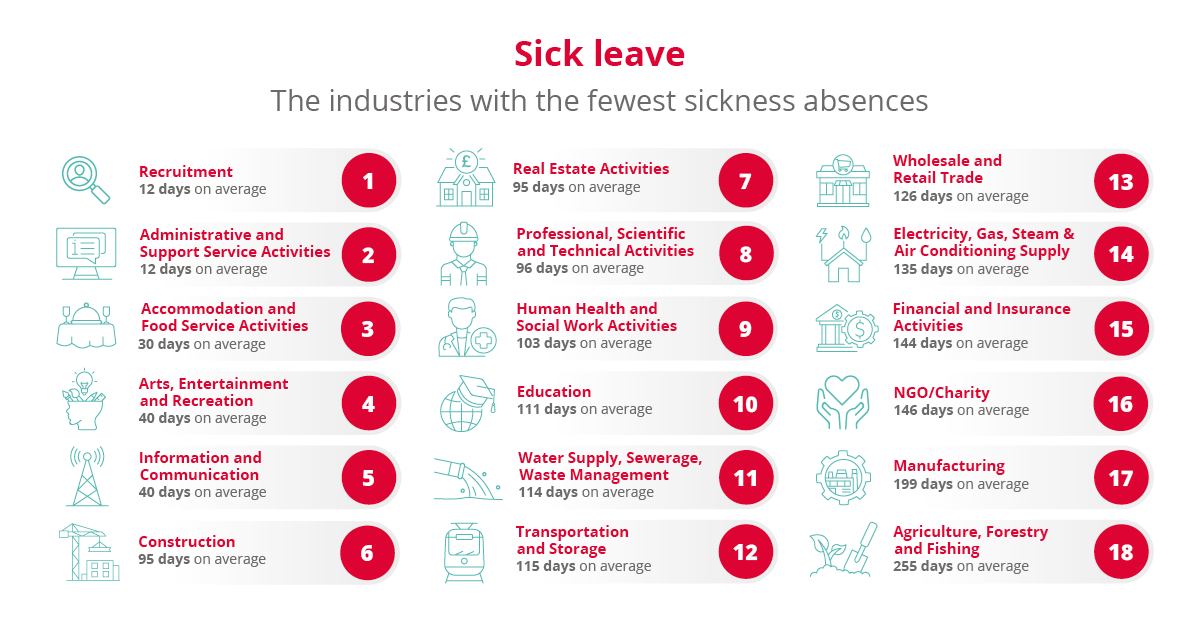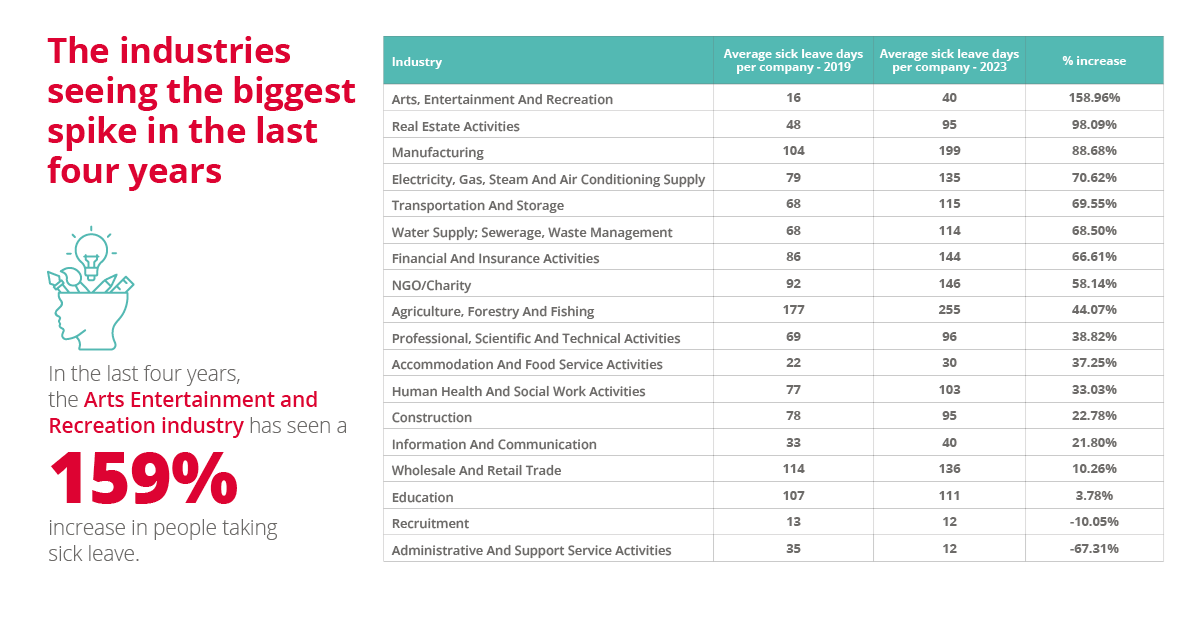
The number of people out of work due to ill-health soared into 2023, following a year of strikes, cost of living concerns and a new era of hybrid-working.
While sickness absence rates from 2021 to 2023 have been much higher than in 2020 and 2021, some of this can be attributed to the fact that people were furloughed, socially distancing post-pandemic, and sometimes working through their sickness at home with the rise of remote roles.
However, sickness rates are continuing to grow year on year, and are also markedly higher than in 2019, indicating that businesses could be facing an industry-wide issue as a longer-term impact of the pandemic.
Employees should feel that they can take time off when ill – but increased levels of sick leave can indicate a number of factors, such as burnout, stress, exhaustion, general illness, or other problems in the workplace.
HR software can help employers to manage their HR and people strategy to help manage absences as best as possible and spot common trends across dates, departments and employees and work with staff to see if there’s any way they’re able to help.
The current status of sick leave in the UK
To do a deep dive into how different industries are affected by the rise in sickness levels, Access PeopleHR gathered the data of absences recorded from over 1,775 small and medium-sized businesses to track sickness leave.
Nationally, the report has revealed that there’s been an increase of 55% in sickness absence rates since 2019.
Each business recorded an average of 128 sick leave days in 2023 - up 6% compared to 120 in 2022.
The average number of sick days taken across the UK in each company:
- 2019 - 81 days of sick leave
- 2020 - 97 days of sick leave
- 2021 - 113 days of sick leave
- 2022 - 120 days of sick leave
- 2023 – 128 days of sick leave
Access PeopleHR research highlights that overall, sick day levels are continuing to increase significantly with the reasons for this changing year on year across businesses.
The overall rise in sick leave levels into 2023 may be due to staff feeling there’s less of a stigma around taking time off to fully recuperate, following Government plans to boost health support in the workplace and reduce long-term sickness.
However, it could also be a sign of deeper issues such as burnout, stress or a general rise in sickness, either industrially, or on an individual or company-by-company basis. This could be partly due to employees in the UK not using all their annual leave entitlement, with days of holiday taken dropping by 7.6% from 2022-2023, increasing the likelihood of burnout, stress, and sick leave taken as a result.
It’s important for employers to proactively identify sickness rates among staff to spot any preventable issues before they escalate. HR systems can help you to easily track and analyse absence patterns, track days of holiday taken or identify those that need to be used, and identify where there’s a problem on an individual nature. Alternatively, it can also help you to spot if there are common days among the year where staff tend to take absences, and if there’s anything you can do to prevent this.
Other ways to reduce sick leave include ensuring that your sickness policy is regularly signposted, encouraging a good work-life balance and full use of holiday entitlement, and not dissuading people from taking sick days if they’re genuinely ill, to avoid burnout.
An industry deep-dive
Access PeopleHR’s research revealed that industries are faring differently when it comes to the number of staff taking sick leave.
The majority of sectors have seen a rise in sick leave rates in recent years, with some rising at a faster pace than others. 

Real estate agents are feeling the brunt of sick leave
Those working in the real estate sector saw a huge spike overall, with a rise of 67% in recorded sick leave in the last year - from an average of 57 days lost per company in 2022, to 95 in 2023.
This rise in absence could be partially down to an increase in face-to-face contact between real estate agents and customers, as more viewings in 2021 and 2022 were virtual as a precaution for the pandemic; while real estate agents may still offer virtual tours, these measures have eased with in-person viewings returning as a more popular choice.
However, the industry has also seen sickness leave skyrocket in the last four years, with a growth in absence of 98% since 2019.
One reason for the huge increase could be due to increased concerns around hygiene and sanitation from consumers following the COVID-19 pandemic, leading to more people taking sick leave for things that they previously may not have deemed necessary, to prevent spreading a contagious illness.
Additionally, the nature of the job working face-to-face with the public could also be a cause for increased absence, as this involves a degree of responsibility and irregular hours which can be emotionally demanding, contributing to burnout and 23.6% of workers in the industry reporting a mental health problem in 2023, according to research by the University of Cambridge.
The recruitment industry saw sickness absence grow
The recruitment sector recorded an increase of 16% in sickness rates - from an average of nine per company in 2022, to 11 in 2023.
Although compared to 2019, sickness rates have dropped in the sector, with a 10% reduction in sick absences in 2023.
Patterns of sickness absence in the recruitment industry reflect the changes in remote-working since the pandemic and the effect this has had on exposure to contagious illnesses. Sick leave dropped in the industry from 2019-2020 when work turned fully remote, proceeding to rise year on year upon the introduction of hybrid working from 2020-2023, although still sitting below 2019 levels.
While many companies mandated a return to the office in 2023 either 2-3 days a week or full-time, 60% of recruitment firms remained remote first with occasional in office time, and 20% stayed fully-remote. The 20% of recruitment companies who increased in-person work in 2023 may have influenced the rise in sick leave, although this could also be due to the still heavily remote-nature of the industry and the impact this can have on your mental and physical health.
The Arts have been impacted
The arts, entertainment and recreation industry has seen the third largest rise in leave across all sectors with a 13% increase year on year - and a staggering 159% growth from 2019. Similarly to the real estate sector, this could be due to the fact that their work often involves being around members of the public, in locations such as libraries, theme parks, leisure centres, museums and historical sites.
As a result, there may be more paranoia around sickness symptoms since the Covid-19 pandemic, as attitudes have changed since “the show must go on, no matter what”, to a mindset of not feeling guilt for taking time off in the sector.
Sickness absence rates driven upwards in financial services
Sickness absence among those working in financial services has increased 13% since 2022, and 67% since 2019, according to the research.
This translates to an average of 143 sick days per company in the last year - up from 126 in 2022.
The sickness rates could be caused by an ageing workforce in the industry, with the average age of a financial advisor in the UK being 58 years old, and one in five expected to retire from the industry in the next five years.
The industry may also need to take a second look at its current ways of working to establish if there are any other underlying reasons or patterns causing this rise in sickness leave, with 43% of financial advisors reporting stress in their job role, and 30% expressing work-life balance as a concern.
Agriculture, forestry and fishing goes against the grain
In fifth position, the agriculture, forestry and fishing sector, with an 11% rise in absences over the past year, up 44% since 2019, despite the work traditionally requiring minimal in-person contact with the public and having less opportunity for the spread of illness.
One reason for absences in the sector could be down to the work typically being outdoors based and physically demanding, leading to higher risk of injury and allergies.
Retail reins it in
The research leans towards the suggestion that those who are more customer-facing, and less office-based are likely to report the biggest growth in sickness absence.
However, the retail sector reported a more modest 6% rise in absences over the last year. Though it’s still seen an increase of 10% overall since 2019.
This could be due to low statutory sick pay in the industry combined with the cost-of-living crisis, which led 76% of retail workers to say they could not afford to take sick leave in a 2022 survey.
Administrative and support services have seen the biggest drop in sick leave over the last year – down by 76%, possibly due to more of these jobs becoming remote due to the nature of the work.

How has sick leave impacted industries in the last four years?
Sick leave has increased year on year in most industries, which may be partially due to the rise of long-covid symptoms in 2020 which were still prevalent in 3.1% of the population in 2023.
Sick leave rates have also increased from pre-pandemic levels, even though 2023 was the first year since lockdown where most industries reverted to pre-pandemic ways of work, mandating a return to the office either 2-3 days a week or full time.
The rise in industry wide absence over the last four years correlates with the continued return to in-person work, with the most common industries reporting growths in sick leave being less likely to work remotely - namely those in the arts, real estate and retail industries.
Although, a lack of exposure to illness during lockdown and periods of remote working could be the reason for more people getting sick in 2023 compared to pre-pandemic levels.
How can businesses help to reduce sick leave?
It’s inevitable - everybody gets sick, and should feel that they can take time off when they’re ill. But how can businesses identify the common causes of absence?
Recording sick leave using HRIS software can help businesses to spot recurring problems, take action and determine whether you may need to conduct an attendance review.
Not all software will match your immediate needs, and as your business grows, it can be hard to take note of all employees attendance, but the right business process can help to:
- Engage employees.
- Analyse retention and identify ways to improve it.
- Prompt staff to book holidays to reduce burnout.
- Send prompts for booking days off to personal devices.
- Identify unengaged employees and understand their reasons for absence.
Other benefits for employers to select the right HR software can be found in the People HR ebook, HR Software Buyers Guide for SMBs.
ENDS
Methodology
Access PeopleHR looked at the sickness leave data taken from 1,775 businesses using the People HR platform, in 18 sectors. It took data for the full years of 2019, 2020, 2021, 2022 and 2023 to understand the correlation between each year.
Data correct as of March 2024.
